#Schema Evolution
Explore tagged Tumblr posts
Text
Supercharge Your Data: Advanced Optimization and Maintenance for Delta Tables in Fabric
Dive into the final part of our series on optimizing data ingestion with Spark in Microsoft Fabric! Discover advanced optimization techniques and essential maintenance strategies for Delta tables to ensure high performance and efficiency in your data Ops
Welcome to the third and final installment of our blog series on optimizing data ingestion with Spark in Microsoft Fabric. In our previous posts, we explored the foundational elements of Microsoft Fabric and Delta Lake, delving into the differences between managed and external tables, as well as their practical applications. Now, it’s time to take your data management skills to the next…
#Advanced Techniques#Apache Spark#Big Data#Cloud Data Management#Data Compaction#Data Efficiency#Data Maintenance#Data management#Data Optimization#Data Performance#Data Retention#Data Scalability#Delta Lake#File Size Optimization#Handling Deletes#Merge Optimization#Microsoft Fabric#Optimize Write#Partition Pruning#Real-Time Data#Schema Evolution#Vacuum Command#Z-Ordering
0 notes
Text
De la Ponzi la Madoff și Caritas – O Istorie a Înșelăciunii
Materialul următor îți va oferi o privire detaliată asupra a două dintre cele mai notorii scheme Ponzi din istorie: cea a lui Bernard L. Madoff Investment Securities LLC și mult-discutata schemă Caritas din România.Rămâi până la finalul videoclipului pentru că vom explora cum au fost construite aceste fraude, ce promisiuni au făcut și cum au reușit să atragă milioane de oameni, de la investitori…
youtube
View On WordPress
#Acțiuni#administrare capital#brokeri#Caritas#clasele de active#Cătălin D. Iamandi#Cătălin Daniel Iamandi#dezvoltare personala#dividende#domeniu financiar#educatie financiara#ETF#Falimentul Madoff#Financial Education#Financial Success#finante personale#Fonduri mutuale#independență financiară#investiții#investiții în acțiuni#investiții în ETF#Investing#investitor#motivatie#R-type Evolution#risc-randament#România#română#Schema Ponzi#subtirare
1 note
·
View note
Note
For the Reverse Unpopular Opinion meme, Lamarckism!
(This is an excellent ask.)
Lamarck got done a bit dirty by the textbooks, as one so often is. He's billed as the guy who articulated an evolutionary theory of inherited characteristics, inevitably set up as an opponent made of straw for Darwin to knock down. The example I recall my own teachers using in grade school was the idea that a giraffe would strain to reach the highest branches of a tree, and as a result, its offspring would be born with slightly longer necks. Ha-ha-ha, isn't-that-silly, isn't natural selection so much more sensible?
But the thing is, this wasn't his idea, not even close. People have been running with ideas like that since antiquity at least. What Lamarck did was to systematize that claim, in the context of a wider and much more interesting theory.
Lamarck was born in to an era where natural philosophy was slowly giving way to Baconian science in the modern sense- that strange, eighteenth century, the one caught in an uneasy tension between Newton the alchemist and Darwin the naturalist. This is the century of Ben Franklin and his key and his kite, and the awed discovery that this "electricity" business was somehow involved in living organisms- the discovery that paved the way for Shelley's Frankenstein. This was the era when alchemy was fighting its last desperate battles with chemistry, when the division between 'organic' and 'inorganic' chemistry was fundamental- the first synthesis of organic molecules in the laboratory wouldn't occur until 1828, the year before Lamarck's death. We do not have atoms, not yet. Mendel and genetics are still more than a century away; we won't even have cells for another half-century or more.
Lamarck stepped in to that strange moment. I don't think he was a bold revolutionary, really, or had much interest in being one. He was profoundly interested in the structure and relationships between species, and when we're not using him as a punching bag in grade schools, some people manage to remember that he was a banging good taxonomist, and made real progress in the classification of invertebrates. He started life believing in the total immutability of species, but later was convinced that evolution really was occurring- not because somebody taught him in the classroom, or because it was the accepted wisdom of the time, but through deep, continued exposure to nature itself. He was convinced by the evidence of his senses.
(Mostly snails.)
His problem was complexity. When he'd been working as a botanist, he had this neat little idea to order organisms by complexity, starting with the grubbiest, saddest little seaweed or fern, up through lovely flowering plants. This was not an evolutionary theory, just an organizing structure; essentially, just a sort of museum display. But when he was asked to do the same thing with invertebrates, he realized rather quickly that this task had problems. A linear sorting from simple to complex seemed embarrassingly artificial, because it elided too many different kinds of complexity, and ignored obvious similarities and shared characteristics.
When he went back to the drawing board, he found better organizing schema; you'd recognize them today. There were hierarchies, nested identities. Simple forms with only basic, shared anatomical patterns, each functioning as a sort of superset implying more complex groups within it, defined additively by the addition of new organs or structures in the body. He'd made a taxonomic tree.
Even more shockingly, he realized something deep and true in what he was looking at: this wasn't just an abstract mapping of invertebrates to a conceptual diagram of their structures. This was a map in time. Complexities in invertebrates- in all organisms!- must have been accumulating in simpler forms, such that the most complicated organisms were also the youngest.
This is the essential revolution of Lamarckian evolution, not the inherited characteristics thing. His theory, in its full accounting, is actually quite elaborate. Summarized slightly less badly than it is in your grade school classroom (though still pretty badly, I'm by no means an expert on this stuff), it looks something like this:
As we all know, animals and plants are sometimes generated ex nihilo in different places, like maggots spontaneously appearing in middens. However, the spontaneous generation of life is much weaker than we have supposed; it can only result in the most basic, simple organisms (e.g. polyps). All the dizzying complexity we see in the world around us must have happened iteratively, in a sequence over time that operated on inheritance between one organism and its descendants.
As we all know, living things are dynamic in relation to inorganic matter, and this vital power includes an occasional tendency to gain in complexity. However, this tendency is not a spiritual or supernatural effect; it's a function of natural, material processes working over time. Probably this has something to do with fluids such as 'heat' and 'electricity' which are known to concentrate in living tissues. When features appear spontaneously in an organism, that should be understood as an intrinsic propensity of the organism itself, rather than being caused by the environment or by a divine entity. There is a specific, definite, and historically contingent pattern in which new features can appear in existing organisms.
As we all know, using different tissue groups more causes them to be expressed more in your descendants, and disuse weakens them in the same way. However, this is not a major feature in the development of new organic complexity, since it could only move 'laterally' on the complexity ladder and will never create new organs or tissue groups. At most, you might see lineages move from ape-like to human-like or vice versa, or between different types of birds or something; it's an adaptive tendency that helps organisms thrive in different environments. In species will less sophisticated neural systems, this will be even less flexible, because they can't supplement it with willpower the way that complex vertebrates can.
Lamarck isn't messing around here; this is a real, genuinely interesting model of the world. And what I think I'm prepared to argue here is that Lamarck's biggest errors aren't his. He has his own blind spots and mistakes, certainly. The focus on complexity is... fraught, at a minimum. But again and again, what really bites him in the ass is just his failure to break with his inherited assumptions enough. The parts of this that are actually Lamarckian, that is, are the ideas of Lamarck, are very clearly groping towards a recognizable kind of proto-evolutionary theory.
What makes Lamarck a punching bag in grade-school classes today is the same thing that made it interesting; it's that it was the best and most scientific explanation of biological complexity available at the time. It was the theory to beat, the one that had edged out all the other competitors and emerged as the most useful framework of the era. And precisely none of that complexity makes it in to our textbooks; they use "Lamarckianism" to refer to arguments made by freaking Aristotle, and which Lamarck himself accepted but de-emphasized as subordinate processes. What's even worse, Darwin didn't reject this mechanism either. Darwin was totally on board with the idea as a possible adaptive tendency; he just didn't particularly need it for his theory.
Lamarck had nothing. Not genetics, not chromosomes, not cells, not atomic theory. Geology was a hot new thing! Heat was a liquid! What Lamarck had was snails. And on the basis of snails, Lamarck deduced a profound theory of complexity emerging over time, of the biosphere as a(n al)chemical process rather than a divine pageant, of gradual adaptation punctuated by rapid innovation. That's incredible.
There's a lot of falsehood in the Lamarckian theory of evolution, and it never managed to entirely throw off the sloppy magical thinking of what came before. But his achievement was to approach biology and taxonomy with a profound scientific curiosity, and to improve and clarify our thinking about those subjects so dramatically that a theory of biology could finally, triumphantly, be proven wrong. Lamarck is falsifiable. That is a victory of the highest order.
2K notes
·
View notes
Text
Okay, I have kinda sidestepped eevee crossbreeds bcuz then I'd have to cover 9 pokemon in one post, and I already had a nightmare covering the Schema Meowstic (24 pokemon that had to be covered), BUT, my mom lives in the wild area and owns a farmland and has a large garden, which attracts a lot of pokemon, and she caught a wild wooly Espeon on camera and now I gotta make this.
Pokemon Crossbreeds: Wooly
Wooly is the name for members if the Eevee line who had Wooloo/Dubwool fathers. The breed has appeared in the wild but started being selectively bred by humans in the 1800s. The bred is known for their wooly fur and floppy ears, and they were bred for various different tasks.
Eevee

Wooly Eevee gain fluffy bodies, floppy ears, and a darker fur coat. They follow the Herd nature of Wooloo and prefer to travel with other Eevees. Their fur grows a lot and needs to be shaved regularly, less it become hazardous for them. Many people breed them for their evolutions, or because they find their wool soft and cute.
Jolteon
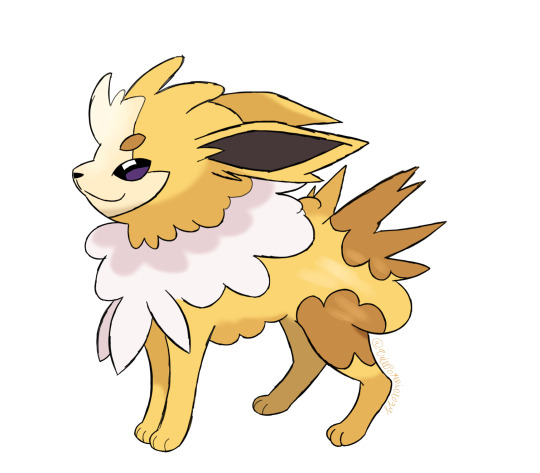
Wooly Jolteon were bred alongside Yamper to be herders for Wooloo, while also working as their protection from outside predators. As to not scare the wooloo, farmers decided that it would be best to breed them with Dubwool so they would have wooly coats and resemble the wooloo herds more. These Jolteon are able to store more electricity due to their wool, making them very popular for battles.
Flareon
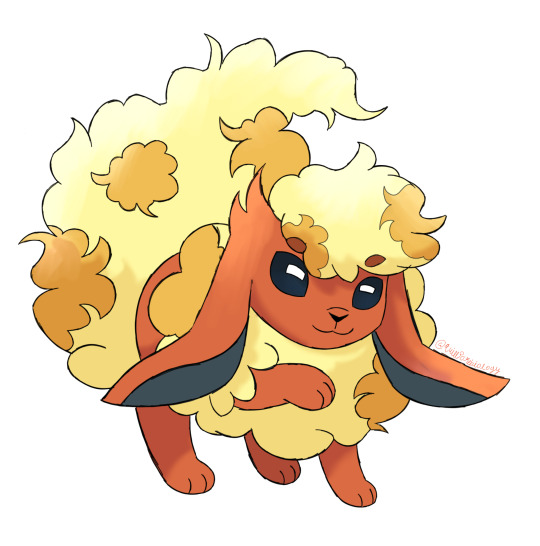
My personal favorite of this line! Wooly Flareon gain the nose, spots, and ears of Dubwool, making them look more sheep-like. This breed of Flareon was bred to keep people warm during winter; with their added floof and warm bodies making them the perfect cuddle buddies. Because of this, this breed of Flareon is known for loving cuddles.
Vaporeon
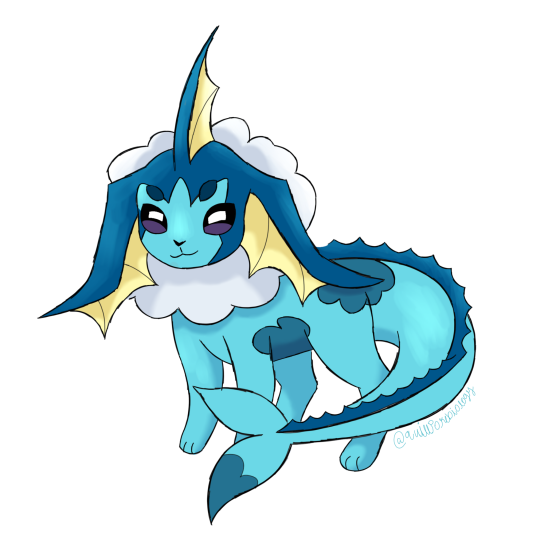
Also nicknamed Koi Vaporeon because of their spots. This breed of Vaporeon gain the face patterns, ears, and spots of Dubwool. Their frills also become wool, which soaks up a lot of water. They were bred for their frills to collect water to bring to villages. The more atee they store, the puffier they get.
Espeon
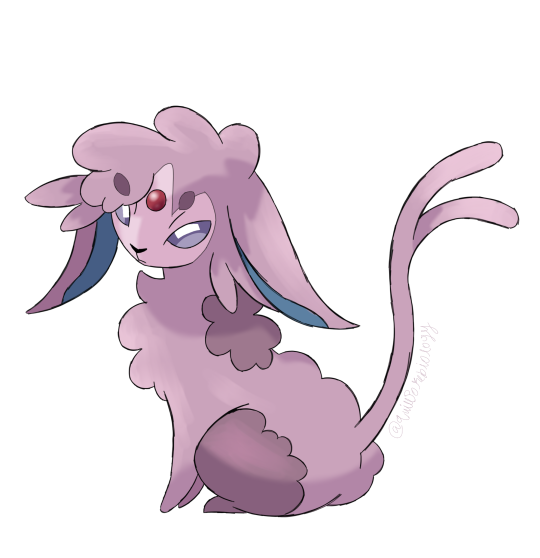
Wooly Espeon gain the floof, spots, facial patterns, and ears of Dubwool. It's one of the more common breeds since Dubwool live on high mountains or in fields that get a lot of sun. This breed was bred by humans purely for aesthetics, since other than inheriting a herd-like mentality and having extremely fluffy wool, not much about them changes.
Umbreon
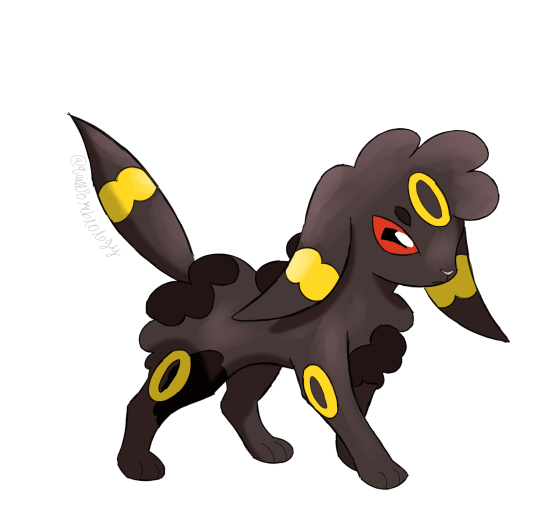
The second most common of this breed. Wooly Umbreon gain the wool, wars, and spots of Dubwool, and that's pretty much it. They were bred to guard Wooloo herds at night from potential predators. Breeding them with Wooloo/Dubwool made the Wooloo trust them more.
Leafeon
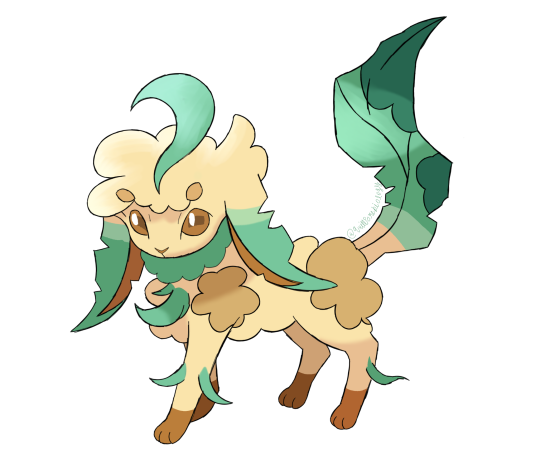
Wooly Leafeon gain the spots, chest fluffy, and ears of Dubwool. This breed is beloved in many children's books and myths because people say they're appearance is just right for a nature spirit. They weren't bred for a specific task.
Glaceon
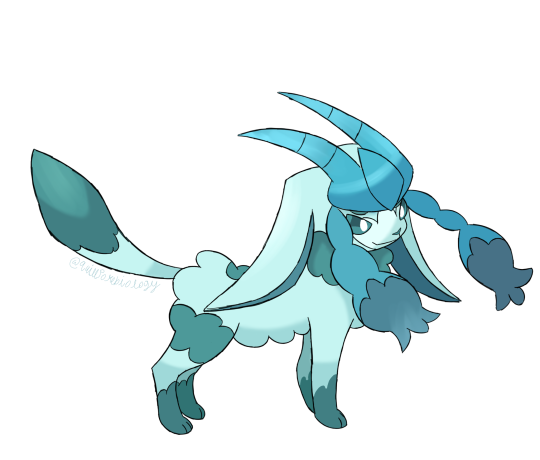
Wooly Glaceon are the only pokenon here that actually gain Dubwool's horns! They can be found atop icy mountains with high Dubwool populations. The breed has been loved on Circhester for thousands of years for their regal appearance, and some myths even state that they're the spirits of Ice God's in the form of a pokemon.
Sylveon
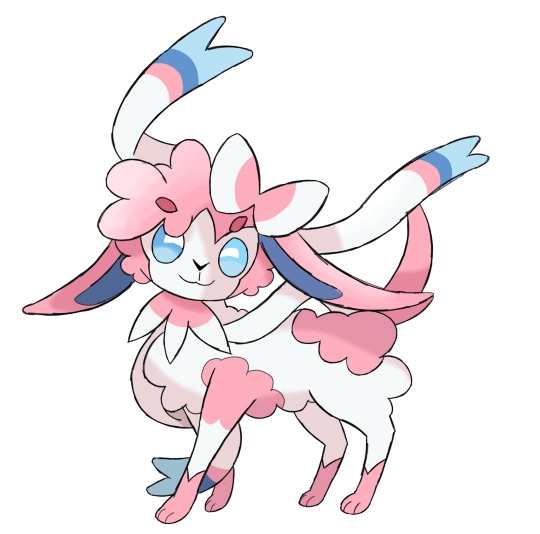
A show breed that is loved by many. These Sylveon gain fluffy coats and cute floppy ears, and many contest judges love their new style of bowtie and their added eyebrows. They're also a very popular pokemon to have on farms, as they can stop fights between the pokemon, they can protect the farm pokemon, and Wooloo feel more comfortable around them because of their wool.
//My designs can be used by anyone if you credit me for the original design! Talking about creation under the cut
I got inspiration for them when I saw art made by GraceyFH on Deviantart, where they crossed an eevee with a wooloo and I thought it was so cute and wanted to make my own version of that. The entire line was inspired by floppy eared sheep and Goats, but Jolteon specifically was inspired by a ram, which is why it's ears aren't floppy.
Eevee was easy. Just give it wool and floppy ears. Except of course it can't be that way because I redraw it twice. The first one's bangs looked weird and unfixable so I started over. Giving Eevee more messy bangs felt more like Pokemon's art style. I gave it darker fur because Wooloo has darker fur, which didn't really stick with the evolutions but idrc.
Jolteon was actually the last one I made. I made a first one with a different pose, but I hated it so I just used the base pose. It was a lot easier to use the base pose since I felt like I could make the fluff and the spiky mix together easier. I also find it very cute. Like I said before, I didn't make Jolteon's ears floppy because that wouldn't help it run very fast, and that breed of Jolteon was bred to hers Wooloo. But, I did make it's ears lower to match the ram photos I was looking at.
FLAREON MY BOY 🧡🧡🧡🧡🧡🧡. Flareon is my favorite I designed and the first one I drew. It was also the easiest since it's already so fluffy. All I had to do was give it spots and goat features.
Vaporeon was the second Eeveelution I designed, and I mostly just had trouble with the ears. Other than that, it was all good. Inwas very excited for Vaporeon because I wanted to draw a koifish looking Vaporeon. Maybe I'll draw a more koifish looking Vaporeon in the future.
Espeon was nice. It already has a simple design. Was going to give it Dubwool's neck fluff, but I didn't do that because I wanted to keep its sleek appearance. (I was also lazy because I didn't realize I forgot it until after I was done with the drawing).
Umbreon was based on a goat at a petting zoo near me (aka, an hour drive away from me but idc I love that zoo). Goat was sleek and had droopy ears, and I loved him. Similar story to Espeon: it's simple and I just added fluff.
Leafeon was nice. I love a lot of nature fantasy stuff, so I'm always happy to make grass type crossbreeds. It reminds me of cauliflower, but I swear I didn't do that on purpose.
I was honestly annoyed about Glaceon since I thought it would he hard to incorporate Dubwool features to it because it's hat. And then I realized I could make the hat into horns, so I ended up having a lot of fun with it. If I didn't love fluffiness, it would probably be my favorite design. Like Jolteon, I based it off of a ram, so I was going to give it upper ears, but I thought the floppy ears looked cuter.
And then Sylveon! It was one of the easier ones to design since I went in knowing what I wanted to do. The floppy wars combined with its everything makes it look like a cute fantasy pet in a Disney movie, and I love it because of that. Not much else to say.
#eevee#jolteon#flareon#vaporeon#espeon#umbreon#leafeon#glaceon#sylveon#eevee crossbreeds#crossbreeds#pokemon crossbreeds#crossbreed pokemon#rotomblr#pokemon irl#pokeblogging#pokeblog#irl pokemon#pokemon#pokeblr#rotumblr#pkmn irl#pokemon roleplay#irl pkmn
439 notes
·
View notes
Text
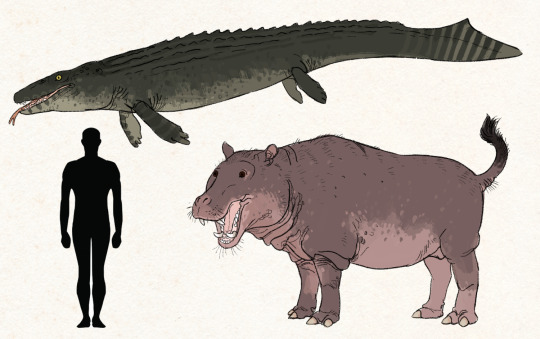
The two greatest beasts found in imperial Wardin's waterways, the river drake and the an-nechoi.
River drakes are actually small freshwater leviathans, with their resemblance to crocodiles being a result of convergent evolution. Juvenile drakes live in small, loose groups, but breeding adults are solitary. Full grown adults of the size seen here are rare, and legends speak of river drakes who grew twice as large in ancient times. This may be rooted in truth, as many of Wardin's rivers have depleted in size orr are heavily trafficked, and territory that can sustain such a large adult is increasingly rare.
They kill humans less frequently than crocodiles (also widely found in this region) but tend to have an elevated place in the cultural schema, partly due to their rarity and partly due to their inconspicuousness (they give live birth and never need to emerge on land, and can live completely undetected in an area for years). It is actually juveniles and smaller adults who are more dangerous to humans. Big, older animals do not need to feed as frequently and tend to reserve feeding for seasonal river crossings by migratory antelopes. They spend most of their time expending little energy, often staying so still at the river's surface to bask that water plants collect on their backs.
Nechoi are a family of large omnivorous hooved animals, and an-nechoi are the biggest and most aquatic of the bunch. Their jaws are exceptionally powerful, used in intraspecific combat. They spend most of their day keeping cool in water (usually slow flowing rivers), emerging at night to feed. Most of their diet is plant matter, but they readily scavenge and opportunistically kill prey.
Adult males form territories stretching up to a mile or so from a riverside and will aggressively defend them against other males (and other large animals that compete for food). Females move freely between territories, flocking to males who control the largest and most bountiful stretches of land. While resting in water, they are comparatively unaggressive and will flock into mixed-sex groups (though males will fight even in water when in the presence of receptive females)
An-nechoi are considered very dangerous to humans. Most attacks on humans are a result of territorial aggression or defense of their young, but are occasionally predatory in nature (and they will usually eat their kill either way). They are also known for stealing catches from fishermen, and appearing at the kill sites of hunters on land to scavenge the carcass. They are rarely targeted in subsistence hunting, but are some of the most sought after game in recreational hunts, with a killing of a bull an-nechoi being a marker of status and glory for an experienced hunter.
#Nechoi are entelodonts fyi. The rest of the family looks less hippo-like and have more hair than these guys#blightseed#creatures
301 notes
·
View notes
Text
"Cinema appeared first as a particular technology at the end of the nineteenth century; but precisely what it would be used for was not immediately clear. The work, both historical and theoretical, of my friend and colleague André Gaudreault indicates that cinema’s purposes were originally less well defined than were its mechanics. As Gaudreault has shown, cinema as a cultural form emerged gradually from a number of differently defined uses and rather separate cultural series. These include: Marey’s need for a means of recording scientifically the movement of bodies: human, animal, and inanimate; the Lumière’s company’s desire to extend the market and methods of amateur photography; Edison’s attempt to “do for the eye what the phonograph does for the ear,” that is, follow one successful recording invention with another. Such examples could be multiplied. Clearly defined goals play a lesser role in technological development than we tend to think.
Rather than following a specific plan and defined purpose, the Edison research lab explored various possibilities in materials and methods, often unsure of, or radically revising, their goal as experiments progressed. Research was often not designed to realize a specific project, but to generate projects generally.
As Bernard Stiegler has claimed, understanding technology as simply devising a means to accomplish an end distorts its nature. The technical object itself (and even more an ensemble such as the Edison laboratory) possesses, as Stiegler puts it, a genetic logic of its own, not simply attributable to human intention. We enter here into the understanding of the technical world introduced by Gilbert Simondon in which we seek, as Muriel Combes puts it, “to know the functioning schemas of technical objects, not as fixed schemas but as schemas necessarily engaged in temporal evolution.�� In Simondon’s theory of technology we move from the goal oriented use of the tool to the open technological environment of the machine and its ensembles (such as the Edison laboratory, open to new uses and revisions). Thus, cinema with its initial variety of purposes may not be aberrant, but rather exemplary of a Simondon’s view of technical development. “The technical object exists, then, as a specific type achieved at the end of a convergent series.” Thus, the technical object must be understood as more than an inert utensil, a means to a predetermined end. Following Martin Heidegger, Tekhne should be conceived as process of growth and unfolding. This is not to claim that the technological processes that resulted in cinema were in any sense random or irrational, but rather that their ultimate outcomes were not necessarily inscribed or foreseen in their origins." —Tom Gunning, Cine-Graphism : A New Approach To The Evolution Of Film Language Through Technology
25 notes
·
View notes
Text
I just finished Spirit. I wish I could write out many more thoughts than I can do rn. This was some of my favorite Doctor Who content overall tbh. Leela and Romana's differences in personality, beliefs, and logic on full display are exactly what I didn't know I needed. Leelas unique and curious role as an outsider in these high-stakes political games was always a factor playing into her character through the series, but it was really the focal point here in a great way. Romana and Leela both represent radical ends of an irl split in epistemic beliefs. I guess people would see Leela as "superstitious," but I really don't think anything she said even comes close to superstition. It isn't religious or fantastical to suggest that there's something "more than" simply biological fact, and everything Leela brings up ("The fruit IS beautiful"; "How does a bird fly for months to reach its home?") is perfectly compatible with rational metaphysical schemas and certainly with evolution. Narrative-telling is constitutive of humans' biological reproduction. If anything, Romanas insistence on a purely empiricist paradigm over Leelas metaphysical tale only reveals that both are just two sides of the same coin. They are both frameworks to apprehend and predict causal efficacy. They both lead to unique and intense views of how the world operates. But neither is wrong. They're both complimentary.
This comes full circle when the two seem to gain parts of the others' personality, which supports the other side of the coin. Romana suddenly *feels in her body* instead of always in her head. She isn't intellectualizing everything through an analytical lense. Instead, she's really feeling her body for the first time. She probably never could feel the way that oxygen cleans her bloodstream so clearly as she did then. Leela feels uncomfortable with her new intellectual abilities. She isn't relying on the multitude of sense-organs distributed across her body to synthesize the presented data. Instead, she's intellectualizing every wave of information, and her brain organ is perhaps much more hyper-active than it was before. In short, Romanas reliance on a rationalist-empiricist epistemology aligns closely with her *inability* to utilize her sense organs deeply, accurately, and with intimacy. Leelas reliance on the specifically neuromuscular and sensory knowledge allows her a more nuanced interaction with the corporeal landscape around her, but perhaps forbids her from constructing a systematized methodology of propositional logic in the way Romana could.
Neither side of this coin is "better" and in fact us humans have the task of delicately tending to both parts of our makeup, both sets of data-gathering tools. The metaphysician and mathematician Alfred North Whitehead essentially investigates the foundations of these differing personalities in his magnum opus Process & Reality (1929). P&R is one of my favorite works ever and to see the Gallifrey series so brilliantly convey the gradation between his categories of "withness of the body" and "presentational immediacy" through the relationship between Leela and Romana has been an absolute delight. Amazing series
"You think of your body as a machine, but it is not. How can such a big mind be so narrow?" -Leela
"But we must—to avoid 'solipsism of the present moment'—include in direct perception something more than presentational immediacy. For the organic theory, the most primitive perception is 'feeling the body as functioning.' This is a feeling of the world in the past; it is the inheritance of the world as a complex of feeling; namely, it is the feeling of derived feelings. The later, sophisticated perception is 'feeling the contemporary world.' Even this presentational immediacy begins with sense-presentation of the contemporary body. The body, however, is only a peculiarly intimate bit of the world. Just as Descartes said, 'this body is mine'; so he should have said, 'this actual world is mine.' My process of 'being myself' is my origination from my possession of the world." -Alfred North Whitehead
24 notes
·
View notes
Text
Endearing through the Alien Lens: A Clue About the Primitive Irken?

I love literary xenobiology. I love it a whole lot, in fact. There’s a paradoxical line I dance across, between criticizing intelligent fictional aliens for their likeness to our species, and criticizing them for their unlikeness. It’s a pretentious and laughable dance between “Come on, the sky’s the limit, there’s no real reason for a bucket of different extraterrestrial races to just all be more flavors of quirky humanoids! Boring, show me something actually alien!!” and the yearn for the use of alien races as a funhouse mirror of mankind’s own evolution. I think the way Irkens nonchalantly dwell somewhere on that subjective tightrope is a good part of why I can’t seem to stop thinking about them.
They are inspired and yet creatively original. They are truly alien, and yet, they can still play foil to the bottomlessly decadent humanity that Vasquez’s Earth has set the stage for.
Before, in the very first brain dump I let loose about them, I noted a few of their parallels to the worst in Homo sapiens and the insects they resemble. This time, something is chewing on me that i haven’t seen another put into perspective. A something that seems contradictory to our collective view of the heartless, sexless, atomized conquerors that all of the cosmos will fear:
They… have parental instincts.
I didn’t necessarily say drives or wants; however, they undeniably havewhat seems to be an actual, instinctual “cuteness response”. Like us, like social pack animals which invest a great deal of resources and time into their young. Given that the closest thing that 100% of smeets born on the home world get to call a parental figure is a literal cold, unfeeling, automated machine, this seems kind of weird, doesn’t it? They’re not even born like mammals or nested like birds, they’re mass produced, like hived wasps or ants, miles beneath their actual society and out of the business of the adults. So, what the heck with them being written to be humanized with this baseless, arbitrary trait?
But, ah ah ah, nitpicker Scarlet, it’s not baseless. It’s only ✨vestigial✨
Y’all could probably make a good guess to what the cuteness response is and why it exists in Homo sapiens, but to sum up- it’s the phenomenon of when we see something we find “cute” and it makes us react to it in a protective, nurturing fashion- or also want to bite/squeeze things, weirdly, if it’s just too damn cute. Well, what do humans find cute? Things that resemble human infants, basically. It’s a biological reflex that makes us want to defend and provide care for our kind’s absurdly dependent and slow-developing young, rather than abandon them in the shrubbery like they’re just screamy, food-leeching paperweights.
“Pff, really? Well I must be special cause I don’t even LIKE babies. I think babies are icky gross, not cute! So, genetic instinct my ass!”
I hear you, sure, but what about… harp seals? Or koalas, or pandas and puppies and fawns and kittens? Or funny little cartoon blorbos? At bare minimum you’d have to be an alien yourself to feel nothing looking at photos of young hedgehogs
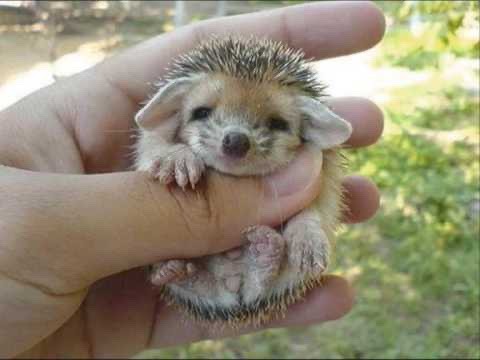
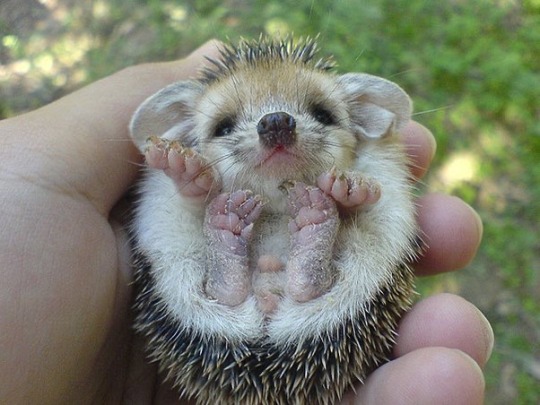
See, the fact that a lot of us may often find baby animals a great amount more endearing than even humans’ is not even in conflict with this understanding of cuteness.
The concept of the “baby schema” was formally proposed in 1943 by Konrad Lorenz, an Austrian ethologist. Fun fact is he was also the same researcher who originally observed and described imprinting behaviors, as seen in newly hatched waterfowl. Point is that his “Kindchenschema” idea grouped together a handful of infantile traits that make fireworks go off in the parts of your brain that wants to keep things alive and baby-talk to them. Included on the list were features like proportionally large heads, big eyes, round faces, short noses, etc. despite the name, the baby schema’s effect is something applied not to just actual babies, but children generally, and even in our reactions to non-human animals.
It’s the hypothesis behind both why we’ve jacked up the skulls of so many small dog breeds in the name of aesthetics and why we generally find the portraits on the left side of this image more appealing to look at than the ones on the right.

The consistency of these features across many species may also give some hint that they experience a similar phenonemon, especially given that these are traits shared among bird or mammalian offspring which require significant attention and protection to survive. And, it may also explain why this image likewise gives me a huge dose of that sweet, sweet response.
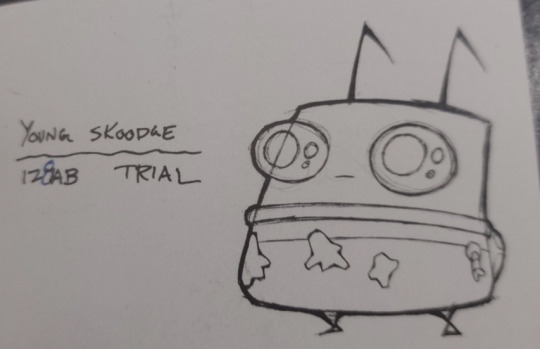
Awww, look at that lil’ mans! Look at his teeny noodle arms!! I just wanna pinch him like a marshmallow!
YOU are not immune to cuteness psychology, and neither are the proud Irken warriors. I’m going to cite Zim’s proclivity to what I can only describe as paternal bonding as a demonstration of this response, but before you go reminding me about his pak defects, it’s far from the only evidence that this is a natural Irken trait.
Check out little Timmy (importantly, the surrounding response to him), a hilariously out of place youngster who appeared briefly in the trial transcript for the sole purpose of a dark gag and to get us some lore revealed.
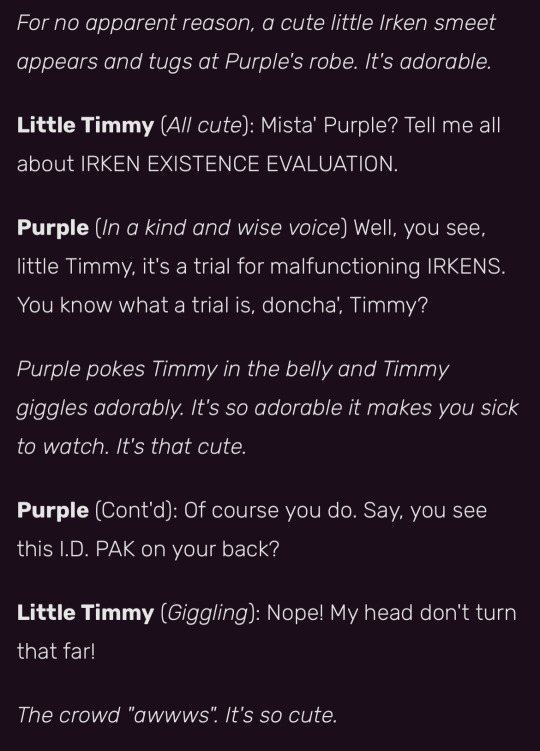
Take further note of the complimentary nature of smeets themselves.

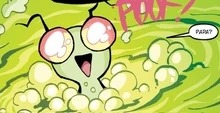
Suddenly finding themselves alive, fresh Irken babies too, like the hatched gosling, begin to immediately seek an emotional attachment with the first animate thing they see. While mobile and fast learners, smeets are far from being able to truly fend for themselves. They’re tiny and naive and they need lots of mental enrichment/teaching. They also play and form something akin to friendships, much like human children. In the bygone era before Irkens were so reliant on Paks and all of the advanced technology of the modern empire, smeets would have been exceedingly vulnerable. All signs point to a phase in Irk’s natural history where they were once nurtured after by adults of their own kind, and commonly bonded with their caretakers. This could mean compact family units, or maybe even a communal raising situation, akin to penguin crèches (Personally I like to headcanon that the tallests/queens were traditionally the only breeding members of the population but that’s neither here or now). Either sense, the evolutionary remnants of a parental creature are still around.
Taking all that to note, instead of perceiving Zim as the bizarre outlier to the Irken condition when it comes to having this soft spot, I instead see him as an opportunity to see natural behaviors in action without the suppression of his militarized society and its distractions. Even someone as warped and selfish as he can be is still very, very full of love to give that he doesn’t even understand enough language to describe. He pretty clearly shows he has no cultural understanding or reference of cuteness, and still, he’s not so different in this “weakness” than the very humans he manipulated into fawning over Ultra Peepi. It just took an example his own sensibilities could relate to instead of an unfamiliar, repulsive alien rodent.
And when he’s given the rare circumstance to show that potential, well-

*(With the rough shape/size down, no nose, and huge, bug-like eyes, Li’l Meat man may actually be a great approximation of the key “smeet schema” features. More importantly, it was made to specifically resemble Zim himself)
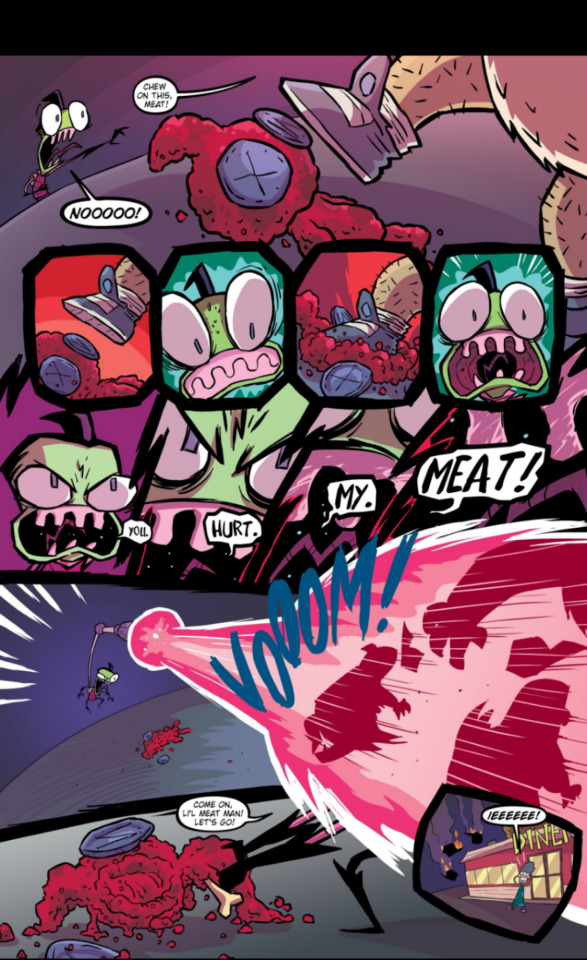
- I feel that’s downright adorable.
#invader zim#iz#iz headcanons#iz theory#irkens#iz comics#iz analysis#Li’l meat man#long post#scarlet talks about things#baby schema
188 notes
·
View notes
Note
I DIDNT . REALISE YOU HAVE OCS. GIVE
[crawls out of a hole wiht dirt caked up under my nails, covered in blood and coughing up violently] I'm a mentally ill queer on tumblr, of course I have OCs!
i also want to preface this by saying im writing it while watching a show and listening to a song on repeat. dunno how coherent this'll be
Okay, so! There are, like. An endless number of little guys is living in my brain. So. The one I'll present here is the 'verse I've been doodling obsessively for two days and which got beamed into my head during a six hours nap literally yesterday.
So, literally the base for this is that They Have Wings, but, um. Make it complicated.
The first recorded mutations have no really known date, but they've been around for long enough that we had centuries worth of data surrounding them, and so we can observe their evolution. The most common mutation is simply winged individuals, following the schemas of birds found in nature. Therefore, there are multiple categories of individuals based on which species they're the closest to, but they're also categorized by the type of mutations they're affected by, eg if they only have the usual wings, the size and function of said wings, the presence or absence of a tail, having more than one pair of wings, etc.
Mutations are visible since birth, except for some rare ones that develop later in life, although there has been a slight increase of those in the latest years.
Not all winged individuals are capable of flight. It greatly depends on the size, anatomy and placement of the wings. Some mutations also bring out disabilities, like when wings replace the individual's arms, or when a small pair of wings replace the ears and render the individual deaf (regarding this, a modified sign language is available to those people where then can use their wings for punctuation, intonation and such, for which people without this additional feature have to use their face only. This addition makes it easier for people who struggle with facial expressions to communicate).
Regarding wings' sizes, there are MANY existing possibilities. Some individuals have proportioned wings that allow them to fly just fine, those sort of common. Some have small wings that do not allow them to fly, and they are still a major part of the population. Some are subject to gigantoalastia, a pathology that causes a GREAT disproportion, making the wings gigantic. These individuals are capable of flight, which requires a lot of effort, but need to do a lot of stretching and back muscular reinforcement because it causes lots of back pain.
The fashion industry is hell, btw. Like if you have gigantoalastia or if wings replaced your arms, your clothing options are quite limited.
Non-winged humans still exist! Around 12-13% of world population is not affected by any kind of mutation. But! That number is actually decreasing, slowly. We might be looking at an all-winged population in a few days or centuries. Mutations are also starting to make individuals more and more birdlike, with characteristics like tails or bird feet. Some beaked individuals have also started to make their appearance, with characteristics developing after birth. Scientists are wondering what this means for the future of our species, and also begs the question of our ancestors!
Both these questions greatly distress people btw. Religious groups primarily. They're divided in different factions, some think at the beginning we were all non-winged humans and that we're evolving towards something holy, some think that at the beginning we were something Other and we lost our whatever-privileges along the way and are only able to reclaim them now. Ofc then there's also exclusion, thinking that non-winged individuals should all be killed, that certain mutations should be wiped out, yk. All that. Which is not even especially religious but can also just be bigotry/eugenics. YK.
OH YEAH ALSO MALFORMATIONS!!!! Disability has of course been Thought About. Some people are born with malformed wings and so fundamentally unable to fly. Other mobility aids are more or less equal to those we have today but flight ones are harder to come by and also hard to design.
Also also sometimes people like to customize their wings with piercings and such :3 dyes are also a thing but temporary because of. Well. Shedding.
(theres supposed to be like. two main guys but actually i thought about the whole entire world before even finding their names. so all you get to know is that they're gay and in a toxic relationship . because thats my brand)
#mine#rambling!!#a gets an ask???#additional information: ive got something drawn for most of those things :3#idk this is still very rough. as i said. this got beamed into my brain during a six hours nap yesterday.
14 notes
·
View notes
Text
Giugno ci regala Emozioni. Tante Emozioni.
Diverse. Opposte. Confuse.
Esse sono il frutto di un maestoso Viaggio esistenziale dentro alla nuova Dimensione del Sè.
Potrebbero rivelarsi a tratti contraddittorie, ambivalenti, enigmatiche.
Potenzialmente sbilanciate e concentrate sugli accadimenti del Fuori, ma non di meno sintonizzate anche sul Dentro.
Potremmo sentirci parte di un equivoco, di una strana scommessa del Destino, che spinge l'acceleratore verso il Nuovo Mondo e lascia indietro tutto ciò che non può accompagnarci nel "dopo di Noi".
Potremmo accorgerci di essere stati catapultati in un "schema non schema", dove tutto appare fermo, immobile, privo di identità, di desiderio, di iniziativa. Dove quasi nulla ha un nome già definito, dove non c'è identificazione, non c'è ruolo, non c'è prevedibilità.
Dove "noi non siamo più noi", ma in fondo "siamo sempre noi".
Apparentemente "un po' meno di prima", ma nella sostanza nulla è davvero cambiato: non ci siamo ancora staccati dal Corpo Fisico, né tantomeno dal funzionamento organico, emozionale e psichico.
Allora dove ci troviamo esattamente, dove siamo finiti?
Siamo fuori dal Vecchio.
Osservatori esterni, a tratti orientati ma spesso totalmente disorientati, delle dinamiche collaudate e perniciose "del prima".
Siamo nel "Tempo del non Tempo".
Una Dimensione Astrale intimamente già conosciuta dall'Anima, ma davvero raramente frequentata dall'Essere Umano.
Ci siamo. Non siamo dissociati o sdoppiati.
Abbiamo funzioni vitali, ma non siamo identificati o "incollati" agli eventi e ai ruoli della nostra vecchia Vita, come invece accadeva nelle precedenti "puntate evolutive".
Siamo distaccati, ma vigili. Siamo connessi, ma "spenti" sul piano adattivo.
Ci muoviamo senza orientamento reticolare. Senza legge dell'attrazione. Senza stimolo-risposta. Senza causa-effetto.
Siamo di fronte ad uno dei più rapidi e straordinari movimenti di "ridefinizione simbolica dimensionale".
Nulla di tale portata era mai accaduto prima d'ora in questa Dimensione percettiva.
Nemmeno le profezie potevano giungere a descrivere con il linguaggio e la strumentazione dell'epoca la portata di un tale "passo vibrazionale".
Ed è per questo che le Regole di funzionamento organico individuale e collettivo "non sono chiare e definite". E non possiamo giungere a soluzioni e conclusioni predefinite, preconfezionate, prestabilite.
Possiamo solo "contemplare" il Dentro che non comprende e il Fuori che scatena il suo, ritardato ma potente, "movimento destrutturativo superiore".
La Materia si avvia verso il processo di "plasmazione". Subisce continui attacchi ed alleggerimenti strutturali.
Si disgrega, si dissolve, si riaggrega. Senza un apparente logica esecutiva.
E il Velo con l'invisibile oramai è sottilissimo. Quasi trasparente.
Ci separano dal Mondo "dell'Occulto e dell'occultato" solo un paio di altri "colpi frequenziali", che all'oggi, con l'aggiunta di qualche fenomeno di riattivazione morfologica, porrebbero definitivamente fine alle "strutture simboliche di antica fattura".
Che cosa può significare per l'Essere Umano?
Ristabilire i naturali equilibri di potere interiore.
Risolvere il conflitto intergenerazionale.
Rompere i Patti di Alleanza disfunzionale, familiare e sociale.
Rinunciare definitivamente agli effetti fotocopia del Trauma.
Porre fine all'antico "oblio del Dono".
Restaurare le primordiali attivazioni e connessioni neuronali.
Resettare il sistema delle informazioni genetiche del Trauma ereditato.
Riappropriarsi della Verità Interiore, rinnovando il Patto con la Scelta dell'Anima e con la sua Origine Dimensionale.
Andare oltre ciò che si vede con lo Sguardo per giungere alla costruzione di una Realtà Autentica, Ispirata, Cristallina.
E questo è possibile perchè ci siamo spostati "fuori dall'area vibrazionale dello Schema", dal suo Campo Simbolico.
Siamo esterni.
E potremmo chiederci, in alcuni frangenti, se sia reale, o magari un sogno, ciò che stiamo continuando a vivere e vedere accadere "dentro lo schema".
Non reale. Non nel "senso precedente". E' in qualche modo solo "proiettivo del ricordo".
Ed è per questo che non dobbiamo credere a ciò che "vediamo con gli Occhi", ma a ciò che sentiamo attraverso la Voce dell'Anima.
La caduta di parte degli schemi del Collettivo sta avvenendo ad una velocità mai sperimentata prima di oggi.
In pochi giorni una fetta di simbolismi collettivi è stata letteralmente spazzata via, manifestando la "realtà dell'Antico" in tutta la sua "crudezza", come mai l'avevamo davvero vista su così larga scala.
Si è scatenato l'Inevitabile, il Sopito, il Nascosto.
Ora è tutto visibile.
Anche la nudità del Re.
Di tutti i Re.
Ma anche l'incomparabile Bellezza dei primi "detentori del Dono".
La Luce estende e amplifica il suo cono di espansione e tocca i Cuori e le Coscienze degli Umani.
Le vivifica. Le riattiva. Le risveglia.
Non si tratta più solo di singoli episodici "precursori del movimento", ma di decine di migliaia di nuove riattivazioni avvenute su larga scala e pronte a resettare le maglie cerebrali dei Simbolismi Antichi.
A breve "si potrà guarire". E guarire molto in fretta.
Perché le fonti che legavano alla ereditarietà del trauma tramite la malattia, si stanno allentando giorno dopo giorno. E non trovano "aggancio per la continuità interstiziale".
Non tutti accederanno "alla fonte del Trauma", all'origine conscia dell'intero processo di desensibilizzazione dalla causa scatenante. Ma per molti non sarà necessario. Guariranno comunque.
Per altri, invece, avverrà una definitiva scelta di "rompersi", una scelta di abbandonare, psichicamente o fisicamente, il Pianeta della Coscienza, per l'eccessivo carico di simbolismi da smaltire e da affrontare in un tempo eccessivamente ristretto per i termini di densità della Materia.
Molto cambierà. Ed in un tempo rapido. Quasi assurdo.
Ogni Guida prenderà il suo posto. Quello determinato dal Dono.
Ogni Dono dell'Origine riconquisterà e dispiegherà la sua innata capacità espressiva.
Vedremo persone apparentemente perse, ritrovare la via, ed altre, invece, smarrirla per sempre.
Fuori la Materia si ritroverà a vibrare con crescente ed esponenziale intensità, con picchi tellurici imponenti e fratture di incomparabile maestosità.
Ma non è come si pensa, o si crede o si vede.
Tutto avverrà nel "rispetto" delle Anime del Nuovo e della loro funzione evolutiva.
E' complesso trovare l'immagine e la lingua per descrivere tali movimenti. Ma essa è dentro la visione del Cuore, che tutto sa e tutto costruisce attraverso i potenti movimenti di connessione allo Spirito.
Non c'è nulla da temere, da rincorrere, da "sperare" o da attendere. E' tutto già avvenuto.
E non è un male o un bene che ci attende, ma un Nuovo. Una sorta di "visto mai visto". Visto dall'Anima, ma mai sperimentato dalla materia (e tramite la materia) del Corpo Fisico.
Accomodiamoci con serenità in questo "vuoto di schema" e tranquillizziamo la parte che si ostina a voler capire, sapere, prevedere, toccare.
Non è il momento di spiegazioni o di indottrinamenti. Non è il momento della paura. Non siamo sotto assedio. Non c'è nessuna catastrofe ad attenderci.
Siamo solo "fuori dallo schema".
Ed è il momento più interessante del viaggio, quello più intenso.
E' il momento di restare settati nella "calibratura" della nuova Dimensione ed accogliere ciò che si palesa di volta in volta, con curiosità, sensitività, fiducia.
E per chi ha definitivamente "scelto" di "esserci per se stesso" e di ammirare questo "miracoloso passaggio interiore", enormi saranno le sorprese, i miracoli, le barriere che si sbricioleranno davanti al Cuore, come muri e palazzi sottoposti ad un movimento tellurico di magnitudo incalcolabile.
Se seduti sul vostro "nuovo Trono Celeste", vi sentiste oggi un po' soli e un po' frastornati, se non intravedete ancora all'orizzonte alcun movimento avvicinarsi a voi, se non si muove alcuna foglia all'orizzonte, è una prova tangibile che tutto sta "funzionando", perché lo schema è oramai un languido e sfocato ricordo e ogni sua costruzione "un pezzo di antiquariato" del recente ed antico Passato.
Giugno sarà questo: il "fuori onda" che mai ti aspetteresti di ascoltare.
Contemplatela con attenzione quella "voce che arriva da lontano". Tendete l'orecchio interiore e non lasciatevi distrarre dal "fuori".
Potreste sentirvi invadere da miracolose "soluzioni" ad annose questioni irrisolte. Oppure incontrare parti di voi sconosciute e mai sperimentate. O ancora, recuperare strumenti e poteri straordinari che non si erano mai liberati dallo spettro e dalla prigionia del Trauma.
Ma soprattutto, anche se apparentemente vi sentite più "soli" di prima, naufragati o esiliati, tagliati fuori dallo schema intergenerazionale, un po' straniti e annebbiati, non cedete alla tentazione di credere che non ne sia valsa la pena.
Anzi. Abbiate pazienza e fiducia.
Tutto si sta compiendo secondo un preciso e definito "ordine sequenziale".
Nulla si sta muovendo nel caos. Assolutamente nulla.
Nessuno è solo. E presto la Vita avrà modo di dimostrarlo.
Giugno vi attende a braccia spalancate.
Non lasciatelo aspettare.
Ha un sacco di novità da raccontare. E tanti incontri inattesi da vivere.
Tanti proprio.
Sempre con affetto, Mirtilla Esmeralda.
4 notes
·
View notes
Text
So, I’ve been thinking a lot about arcane recently and I can’t figure out some paradox happening with the last episode (about Viktor, more specifically)
Obviously, spoiler alert, I will try to understand what exactly happened (also English isn’t my first language, so sorry for the mistakes)
In the last episode we learn that Viktor is the one who saved Jayce and his mother, back when he was a child.
He did it after the “Glorious Evolution”, after everything was just “fields of dreamless solitude”
But, where did that Viktor come from ?
I did a schema of the different timelines/Alternative Universe we learn about in the show, so, the timeline we know (Arcane’s timeline), the one Ekko and Heirmerdinger go to (Ekko’s AU, the “good timeline”), the one where Jayce go (Jayce’s AU, the “bad timeline”) and an implied 4th timeline where Mage Viktor come from (the OG timeline)
In the 3 first timelines, Jayce is saved by Mage Viktor, but he couldn’t be saved in the fourth, because he couldn’t be saved at a time where Mage Viktor didn’t exist yet.
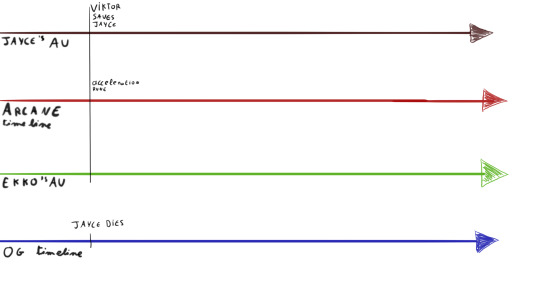
In the timelines where Jayce survives, he’s able to create hextech. But as we know, in Ekko’s timeline, Vi dies because of it, which cause the end of any hextech researches, and prevent the creation of the Hexgates
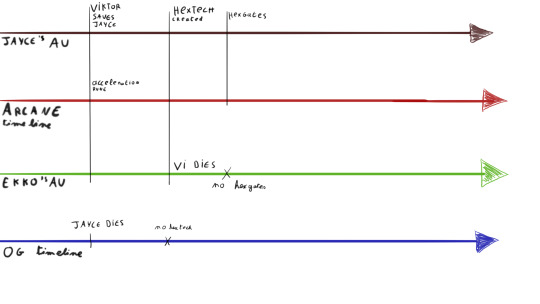
With the Hexgates, the Arcane Anomaly is created, which will send Ekko and Heimedinger in the “good timeline”, and Jayce in the “bad” one.
Ekko will be able to create the Z-drive with his knowledge about the acceleration rune Mage Viktor gave to child Jayce in the Arcane’s timeline (the only timeline where this specific rune is given)
Jayce on his side, saw the atrocities of the future they’re heading to, and was able to talk to mage Viktor (who sent him back in his timeline)
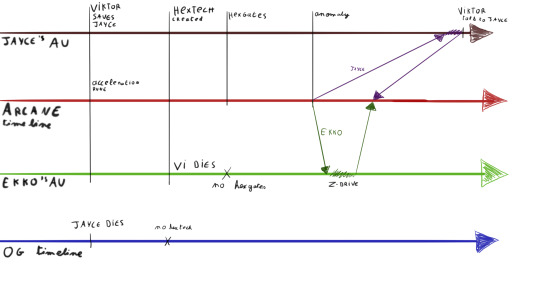
Then, Jayce tries to kill Viktor. Singed helps Viktor with the “Glorious Evolution”, then goes the war between piltover/zaun against Ambessa and Viktor.
Viktor was about to “win” but thanks to Ekko and his z-drive, Jayce is able to talk to him and show him Mage Viktor’s words.
They then make things right and save everyone and are disintegrated (?)
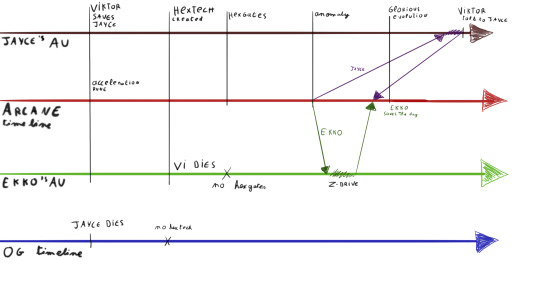
Here’s the problem : for Mage Viktor to even exist, hextech needs to be created, but we can see that in a timeline where Mage Viktor doesn’t exist yet, Jayce dies, so no hextech is created, and so no Mage Viktor.
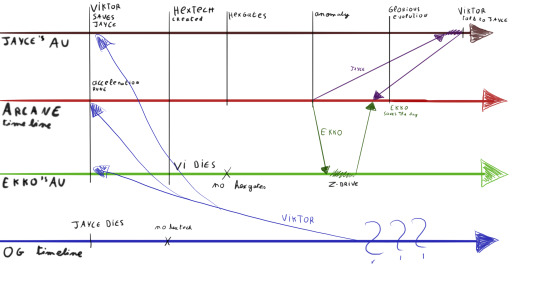
So where does Mage Viktor comes from ?
Especially since, in the OG timeline, nothing should be as bad as the Arcane timeline (like Ekko’s timeline but Vi is probably still alive too)
The only possibility I can see is another timeline, where hextech is still somehow created, and where Mage Viktor would have found out he needs Jayce to make things right.
Maybe a timeline where Jayce simply don’t die in the cold for whatever reason?
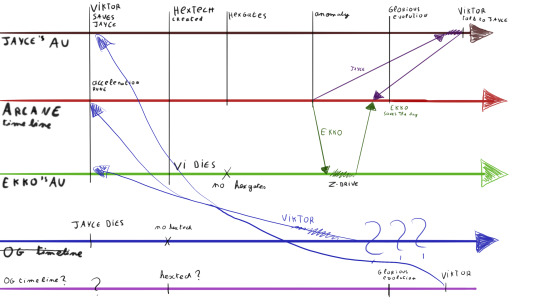
Anyway, I’d be happy to hear what people think about this, if there’s something I’m missing ?
Somehow, I think it might just be a mistake from the scenarists but since I like things related to time travel and Alternative Universe, I still wanted to understand.
Again, sorry for the mistakes if I did any, it’s like 2 am and I just wanted to write this before going to sleep
#arcane#arcane season 2#arcane season 2 spoilers#arcane viktor#arcane jayce#arcane ekko#arcane heimerdinger#arcane theory#arcane thoughts#fan theory
3 notes
·
View notes
Text
A History of the Severan Conflicts, by Prof. Siddhartha Scipio
Part 1: The First Severan War and its Causes
To understand the history of armed conflict between the Imperium Humanum and the House of Severan (formally the Severan Dominate, although the nature of their society makes actually naming their political systems with any permanent name an exercise in futility. Aemilius Sade’s Politics in the House of Serpents is an excellent primer on Dominate politics), one must understand the role prophecy and future-parsing has in both Severan society and more importantly, in the Severan religious schema. Both blessed and cursed with extremely vague powers of precognition, a quirk of the Innis’arotan’s (while the various Dominates throughout galactic history have featured multiple member species, the current ruling Severans are Innis’arotan) prescience is a universal prophesied threat.
Across the many thousands of sects, sub-sects, heresies, orthodoxies, cults and other ephemera that make up Severan religious traditions all have some variation on a mysterious enemy hailing from the stars, one who, strangely enough, looks just like the Innis’arotan. For thousands of years this was largely seen as metaphorical, that their greatest threat was themselves.
Surely enough, no one was more shocked by humanity’s arrival on the galactic scene than the Innis’arotan, and by extension the Severan Dominate. Here we were, upright bipeds, two arms, two legs, eyes, ears, mouth and nose. And there were the Innis’arotan, with all those same features.
You see, by some sheer impossible coincidence, a complete quirk of biology and evolution and sheer dumb luck, humans look nearly identical to the ruling Severan species. Here we were, young upstarts on the galactic stage, fresh off a victorious, desperate war for our very survival against the Aberinian Clan Kilaurus. Immediately, we’d set about shaping the state of galactic society to fit our ends, signing treaties and forming alliances, many of them with long-standing rivals or even enemies of the Severan. Our fleets were expanding rapidly, and only 20 years after our arrival on the galactic stage, we’d swelled our ascendant Imperium to over 200 worlds. We had a rapacious hunger in our early days, and it was a horror to behold for the Dominate. Here we were, the very thing from their religious nightmares, their most scare texts and holy beliefs warning of our threat.
The Severans resolved that they would be the ones to triumph in this inevitable clash of holy versus unholy. Of course, almost all of this was unknown to the Imperium, who made dozens of attempts at diplomatic inroads in the early days.
The first flashpoint in our brewing conflict with our strangely cagey neighbors to the galactic west came out of what was, admittedly, a low moment for Imperial foreign relations. In August of 2415, an Imperial customs frigate forcibly boarded, without authorization from Naval High Command or notifying the Dominate, a Severan cargo macrotransport in the neutral frontier system of Devorno.
The customs frigate had suspected, based on Naval reports, that the ship was smuggling weapons tech to an enclave of frontier pirates who had recently been edging in on some Imperial interests in the region. While this would prove to be true, the transport was indeed carrying fabrication schematics for naval weapons, what came next would prove to be a gross violation of any standards of diplomacy or sensibility, Imperial or otherwise. Under the guise of an old war-time law authorizing naval captains to execute captured enemy personnel, if it was believed they could not be securely detained and that their release or escape would lead to further Imperial casualties, Civil-Captain Dante Nimerius ordered the officers of the captured Severan ship ejected into space.
While the disgraced captain would see severe punishment for this, tried and charged in front of a naval tribunal, to the Severans, this was every sign they had been waiting for since they first met us. This was their indicator that we were everything they believed us to be, duplicitous, callous, and cruel. The next few blunders in Imperial diplomacy would not soon disabuse them of this notion.
#trying my hand at some in-universe historical accounts#I tried to change the tone and style here from the other historical entries but I’m not 100% sold#also I promise the Severan stuff gets both more interesting and more weird as it goes on#most of this is happening in the 2410s and our first conflict with them isn’t until almost a hundred years later#there’s so much time for both sides to get worse#the victusverse
4 notes
·
View notes
Text
The Future of XMLTV in the Digital Landscape of 2024

As we navigate through 2024, the digital entertainment landscape continues to evolve at a rapid pace. Amidst the plethora of content delivery formats, XMLTV stands as a significant tool for electronic program guides (EPGs) and other applications requiring TV listings. In this blog post, we will explore the future of xmltv epg source and delve into how search engine optimization (SEO) and digital marketing strategies can be effectively incorporated into the XMLTV framework to ensure maximum visibility and user engagement.
Understanding XMLTV in the Current Digital Ecosystem
XMLTV is a standard for TV listings that is used by a variety of applications to display up-to-date programming information. Despite the rise of on-demand streaming services, XMLTV remains relevant for traditional broadcast and cable television, as well as for IPTV and other emerging platforms that offer live TV options.
SEO Optimization for XMLTV
Optimizing XMLTV for search engines is crucial for reaching the widest possible audience. Here’s how you can ensure that your xmltv guide data are SEO-friendly:
Keyword Research
Identify Relevant Keywords: Focus on keywords that potential users might search for, including the names of shows, channels, genres, and specific airing times.
Use Long-Tail Keywords: These are more specific and less competitive, which can help in ranking higher for niche queries.
Metadata and Tags
Title Tags: Incorporate relevant keywords into the title tags of your XMLTV files. This helps search engines understand what the content is about.
Meta Descriptions: Write clear and concise meta descriptions for your XMLTV listings that include targeted keywords.
Schema Markup: Use this to provide search engines with detailed information about the TV listings, such as the time, channel, and program names.
Content Quality and Freshness
Regular Updates: Keep the XMLTV files updated with the latest programming to ensure that the content remains fresh, which is favored by search engines.
Unique Content: Make sure the descriptions within the XMLTV are unique and not just copied from other sources.
Digital Marketing Strategies for XMLTV

To enhance the reach and effectiveness of xmltv guide, integrating digital marketing strategies is essential.
Social Media Integration
Share Updates: Use social media platforms to share updates about new and popular TV shows or changes in the schedule.
Engage with Viewers: Create interactive content that encourages viewers to engage with the listings, such as polls or trivia related to the shows.
Email Marketing
Newsletter Subscriptions: Offer a subscription service for viewers to receive personalized TV guides via email, tailored to their interests.
Segmentation: Use segmentation to send targeted emails with listings that align with the preferences of different audience segments.
Partnerships and Collaborations
Work with TV Networks: Collaborate with television networks to get exclusive content or early listings that can be promoted as a USP (Unique Selling Proposition).
Syndication: Syndicate your xmltv listings with other online TV guide services to expand reach.
Analytics and Performance Tracking
Monitor Traffic: Use analytics tools to track the traffic to your XMLTV listings and understand user behavior.
SEO Performance: Regularly check your rankings for targeted keywords and optimize accordingly.
The relevance of XMLTV in 2024 is multifaceted, catering not only to traditional TV viewers but also to users of digital platforms seeking a comprehensive TV guide.
Gathering insights into the importance of anchors link building in seo and robust digital marketing strategies in the XMLTV framework, content creators can ensure that their listings are not only visible but also engaging for viewers. As we look toward the future, the integration of technology and strategic marketing will continue to play a pivotal role in the evolution of television content delivery.
The key to success with XMLTV lies in the ability to adapt and innovate, ensuring that the content meets the dynamic demands of the modern user while staying ahead in the competitive digital space. By following the guidelines provided, XMLTV providers can optimize their presence and offer a valuable service to viewers worldwide.
youtube
12 notes
·
View notes
Text
Fairy Tale - short story usually that is part of folklore/folktales . But did you know the most famous take of them, the German tales we've all come to hear & love, aren't exactly fairy tales? But really, they're considered "Wonder tales" or, tales of wonder.
Among the oldest that we can trace are some that come from South Asia and the Middle East, the exact origin/time frame is unknown as they have a history of existing first as oral tales in verse/poetic form that were later written down, then translated again into prose.
But the point of these folk tales were to elicit a sense of wonder - that they did!
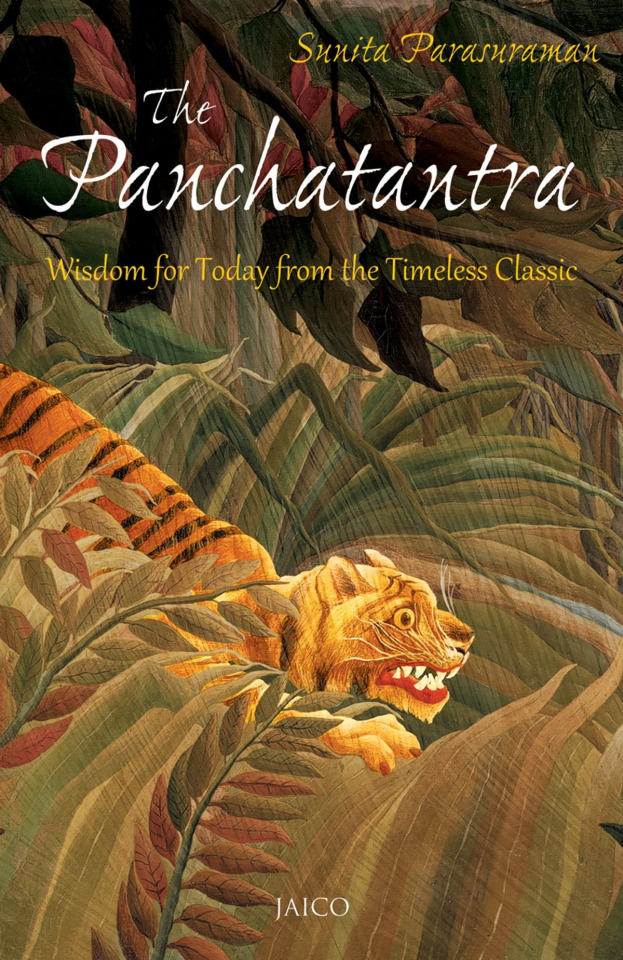
The Panchatantra is an ancient collection of interrelated animal fables written in Sanskrit. It varies from story to story in prose format as well as verse all within a frame story.
The earliest known translation of it in a Non Indian language dates to 550 CE and is translated into Middle Persian.
Many of the fables within also share and discuss life lessons, morality, and things to contemplate beyond the wondrous stories themselves.
There are lessons to take away, as well as, for those interested in shared/comparative mythology/storytelling, beats and similar tropes/takes of tales you might recognize 🤔
Some examples can be the snake and the mongoose story, which later likely served as inspiration for Rudyard Kipling's Rikki-Tikki-Tavi.
And while considering the history and travel/trade of stories and their evolution (something Tales of Tremaine is about), here's something to consider:
"Sanskrit literature is very rich in fables and stories; no other literature can vie with it in that respect; nay, it is extremely likely that fables, in particular animal fables, had their principal source in India." — Max Muller, On the Migration of Fables
Now, something ELSE you MUST take into account in this is how stories travel and originate. Most are for a mix of reasons, and you can't take out PIE (proto indo european) influences, then the silk road/trade migration, as well as storytelling structures once taught take on their own lives. Every culture has animals, so the motifs, tropes, beats, are going to be taken and then reapplied to a local culture.
Many scholars have noted and commented on the strong similarity between some of the stories in the Panchatantra and Aesop's Fables. And so the Panchatantra has come to be held by many as the source or most prominent source of many of the fairy/wonder tales content/structure/shape we've come to know today.
Vijay Bedekar in the History of the Migration of the Panchatantra has noted that origin of several of the stories in Arabian Nights, Sinbad, and 30-50% of western nursery rhymes and ballads have their origins in the Panchatantra as well as the Jataka tales (another collection of folk stories, about Buddha and many lives/forms/incarnations.
Many Jatakas are told with a common threefold plot schema which contains a “narrative in the present” | paccupannavatthu |, with the Buddha and other figures, a “narrative in the past” |atītavatthu|, a story from a past life of the Buddha, a "link" |samodhāna| in which there is an “identification of the past protagonists with the present ones.
If that seems familiar, it's because you'll see this sort of played out as well in Tales of Tremaine through items/characters - timeline.
But, how did this come to travel so far and wide? Wheeeeellllllllllllllll. Do you remember Nalanda, and how far it drew students from as the oldest residential university, catering to students interested from afar most especially in Buddhism?
Whaaaaale. That's how. The records we have indicate that Buddhist monks traveling along brought copies of the texts, along with other Sanskrit texts to: Tibet, China, Mongolia, and all throughout South East Asia where Buddhism can be found.
One of the earliest stories of panaceas and life saving magical herbs spread from South Asian stories. One early record of this which has now become a trope is found in the 10 century in where a Persian physician read about an herb that could restore a dead man to life and wished to find it with his king's blessing.
Narrator: He did not find the herb.
Anyways, after spreading to the Middle East, the Arabic translation of this collection was later translated to Greek then Spanish - old Castilian, and then into Hebrew by Rabbi Joel in the 12th century. Then Latin.
Anyways, Forest Gump voice: that's all i have to say about that (not really but for now).
#folktale#folklore#folktales#German tales#fairy tales#fairy tale retelling#animal fables#fables#translation#translated literature#lore#magic#buddhism#arabian nights#sinbad#panchatantratales#panchatantra#aesops fables#sanskrit#literature#literary history#literary analysis#r.r. virdi#rrvidri#Persia#asia#middle east#rikki tikki tavi#rudyard kipling
6 notes
·
View notes
Text
Pokemon Crossbreeds: Schema (Part 2)
(Name from @mutsuowo)
Schema is the name for members of the Espurr line with members of the Eevee Line fathers. They get their name from it being a term for psychology and coding, referring to Eevee's multiple evolutions. (First post)
+Glaceon
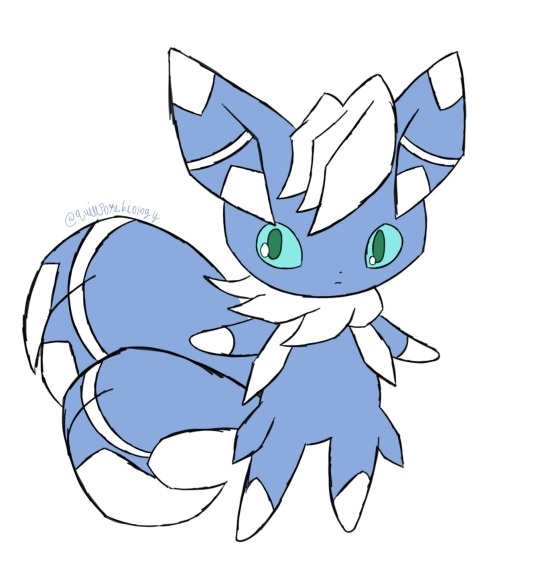

Schema Meowstic crossed with Glaceon gain pointed patterns instead of the usual circular ones and lighter fur. This breed is rare since Espurr isn't usually found in colder climates. If you want your Schema Espurr to evolve into this version of Meowstic, take it to a cold climate and hope for the best.
+Leafeon

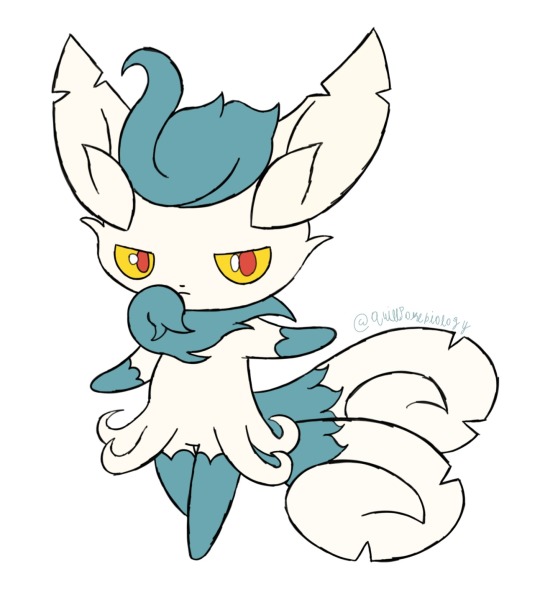
My personal favorite of the Schema Meowstic breed. This variant gains teal fur and the messy patched fluff that resembles Leafeon. This breed isn't uncommon, but it's still hard to get since most Schema Espurr that live in the forest will evolve to have Espeon traits instead of Leafeon.
+Jolteon
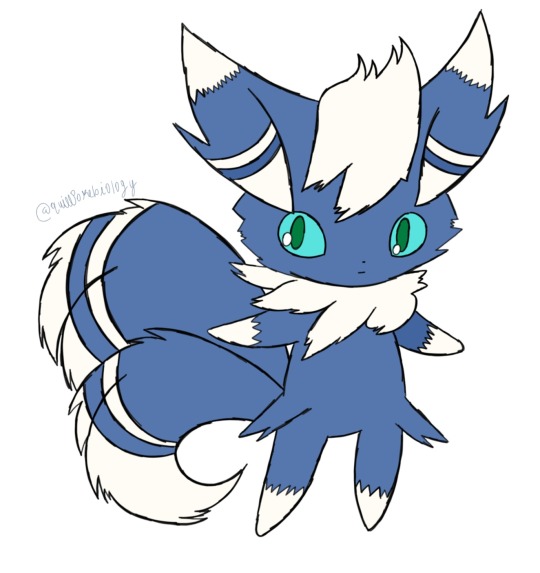

This variant gains staticy fur and spiked markings. Schema Espurr most often evolve into this breed during thunderstorms, but u wouldn't recommend purposely trying to get it because it can be dangerous. The breed's fur is more staticy and can give a small shock when touched, but nothing painful.
+Flareon


My second favorite of this variant! Meowstic crossed with Flareon are slightly bigger and a lot more fluffier with larger tails. They also gain flame-like patterns on their bodies. The breed is slightly warm to the touch and is very popular in the fashion industry due to how much they shed. Getting the breed is difficult though, unless your in extreme temperatures), since even if they're in hot weather, Schema Espurr will still most likely evolve into the Espeon variant.
+Vaporeon


Meowstic crossed with Vaporeon going thinner tails more suited for swimming and whiskers that resemble the fins of Vaporeon, though they aren't actually find themselves. The breed is most commonly found near beaches. This breed appears in many Kalosian fairytale as mermaids. While they can do better in the water, they don't gain water typing and can't breathe underwater like Vaporeon can, so be wary if that when training them!
//My designs can be used by anyone if you credit me for the original design!
#meowstic#meowstic crossbreeds#pokemon crossbreeds#crossbreed pokemon#rotomblr#pokemon irl#pokeblogging#pokeblog#irl pokemon#pokemon#pokeblr#rotumblr#pkmn irl#pokemon roleplay#irl pkmn
104 notes
·
View notes
Text
I am quickly realizing you can use tumblr for literally whatever so here are cartoon characters that somehow managed to inform my gender identity even though I am a cis man and there is very little to figure out
These are all very stupid and I don't expect a single other human being to gain anything of value from the list. However, it was fun to make this list and I'm probably gonna look at it later and go "huh. neat" which is all you need to know sometimes
Death from adventure time I am not like him in any way he is just a synthesis of what I thought was cool and badass as a teenager and also a normal and kind of lame dude which made me go "Wow, that's achievable and you can do it without being some kind of shithead" The hierophant from adventure time Literally I just want to give off the same general vibe you get looking at him. Nothing about his actual character. I saw him and imagined a guy that was cool in a way that I thought would be fun to be and then kept that mental model in my head and ignored everything else about him Mayonnaise from Split the Room The exact same thing from the hierophant applies here. The only new thing to add is that I used the Mayonnaise mental model when visualizing the story of an Armenian guerilla fighter I was listening to in a podcast and the psychic cross contamination made me have to demote him from Abstract Aspirational Qualities Model Bob Belcher from Bob Belcher's Burgers Despite my total disinterest in Bob as a character whenever I think of the definition of masculinity I have cobbled together for myself his image just hangs out in the back of my head. And you know what yeah he does kick ass in that regard. He's pathetic and level-headed and he's exerting agency to provide for himself and the people he cares about. Good job Bob. The show you came from got kind of boring after a while. Mr Fox from Adventure time This is kind of a cheat one because Mr. Fox didn't inform this, it's more convergent evolution. But the respects in which I have molded my personality to be a specific Kind of Guy in the greater Guy schema have caused me to talk extremely like him. Will I pass through his guy territory onto greener guy pastures? Probably not actually I think I'm calcified. I'm not too torn up about it though Mr Fox from that Wes Anderson movie This one was when I was 14 I don't really think it applies now. I think his whole spiffy suit debonair adventurer schtick sucks actually. He's only on this list because I thought he was cool once and I don't want this list to be 75% tertiary adventure time characters Buck from Ice Age This one I was even younger and emulating him exactly is probably gonna be worse for you long term than Mr Fox (Wes anderson) but even despite that and the whole Grizzled Mountain Man(tm) thing I like him a bit more. There is a Buffoon quotient and an Extremely Disheveled quotient there that has embedded itself into my worldview.
#adventure time#bobs burgers#the fantastic mr fox#ice age#the last two aren't endorsements just to be clear they just wormed myself into my social schema when I was 12#fandom
10 notes
·
View notes